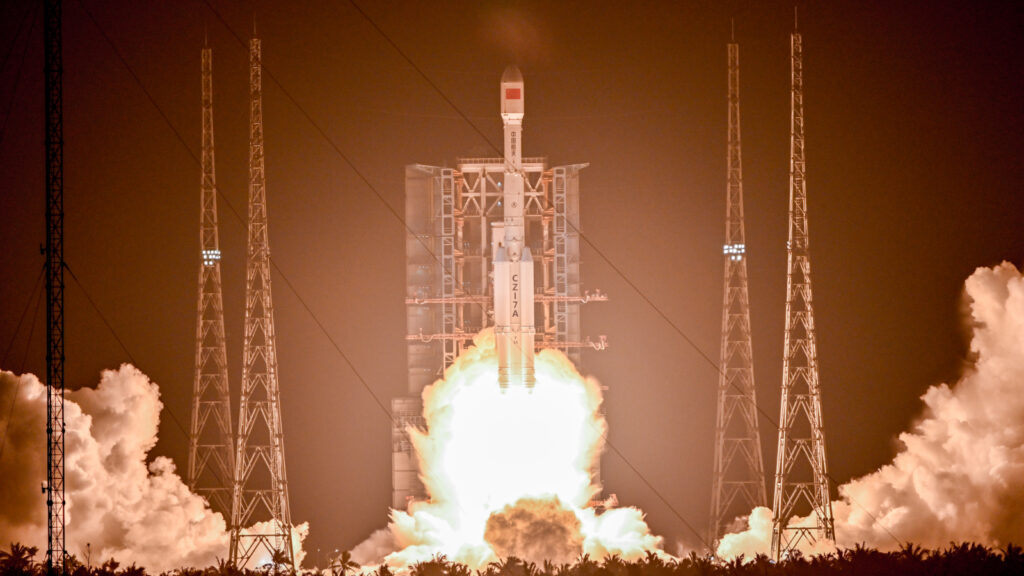
China has launched its first cluster of satellites for a planned artificial intelligence (AI) supercomputer constellation in space.
The 12 satellites are the beginnings of a proposed 2,800-satellite fleet led by the company ADA Space and Zhejiang Lab that will one day form the Three-Body Computing Constellation, a satellite network that will directly process data in space.
The satellites, which launched on board a Long March 2D rocket from China’s Jiuquan Satellite Launch Center May 14, are part of a plan to lower China’s dependence on ground-based computers.
Instead, the satellites will use the cold vacuum of space as a natural cooling system while they crunch data with a combined computing capacity of 1,000 peta (1 quintillion) operations per second, according to the Chinese government.
“It’s a good time to think about how we can put AI into space, not just in your laptop or cellphone,” Wang Jian, director of Zhejiang Lab, said at the Beyond Expo tech conference in Macau Wednesday (May 21), the South China Morning Post (SCMP) reported. “Space has, again, become the frontier for us to think about what we can do in the next 10, 20 or 50 years.”
Whether satellites are used for GPS systems, climate sensors, telescopes, weather forecasting or communication, many organizations increasingly rely on the observations made by orbiting spacecraft. But this raw data needs to be crunched back on Earth, meaning it’s limited by transmission bandwidths and the narrow windows it can be sent as satellites pass over ground stations, meaning a lot of it is lost.
Related: China plans to build enormous solar array in space — and it could collect more energy in a year than ‘all the oil on Earth’
To overcome this restriction, companies have begun designing satellites capable of “edge computing,” where raw data is processed on board the satellite before being transmitted down to the ground. Doing these energy-intensive computations in orbit also allows the satellites’ power to be drawn from solar panels and their waste heat radiated into space, thereby lowering their carbon footprint.
Each satellite in China’s launch contains an 8 billion-parameter AI model that can perform 744 tera operations per second (TOPS), according to a translated ADA Space statement, with the number shooting up to five peta operations per second when their processing power is combined. For reference, Microsoft’s AI Copilot+ laptops can currently process at a rate of around 40 TOPS.
Orbiting in an array, the satellites will communicate with each other using lasers, one of which is equipped with an X-ray polarization detector for studying cosmic phenomena such as gamma-ray bursts.
The computing constellation gets its name from the three-body problem, a question first formulated by Isaac Newton that involves predicting the chaotic motion of three objects orbiting each other under the effects of gravity. The quandary served as inspiration for the renowned science-fiction trilogy of the same name written by Chinese author Liu Cixin, alongside a Netflix adaptation.
This initial inspiration carries over to the purported aims of the constellation, according to Wang, who highlighted the complexities of working with multiple entities in a call for increased international cooperation in the project. He claimed that the array will permit other international organizations to build and use its computers, the SCMP reported.
Although the U.S. and Europe have performed tests on space computers, China’s array is the first to be deployed at an operable scale. Meanwhile, former Google CEO Eric Schmidt, following his purchase of a controlling interest in the California launch company Relativity Space, has proposed launching data centers into orbit.
“People are planning 10 gigawatt data centers,” Schmidt said during an April 9 hearing with the U.S. House Committee on Energy and Commerce. “It gives you a sense of how big this crisis is.”
“One of the estimates that I think is most likely is that data centers will require an additional 29 gigawatts of power by 2027, and 67 more gigawatts by 2030,” he added. “These things are industrial at a scale that I have never seen in my life.”
